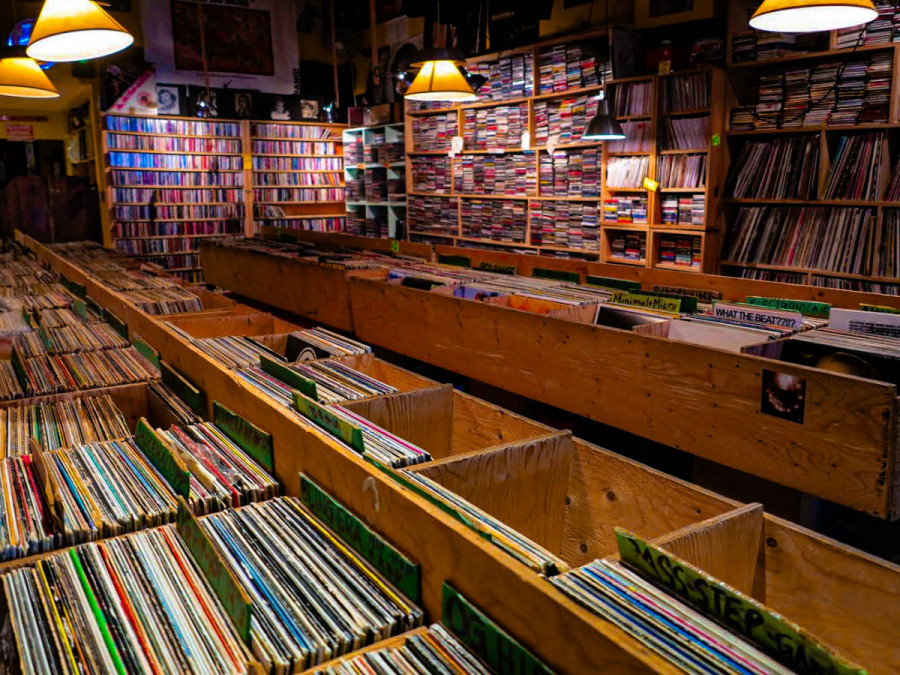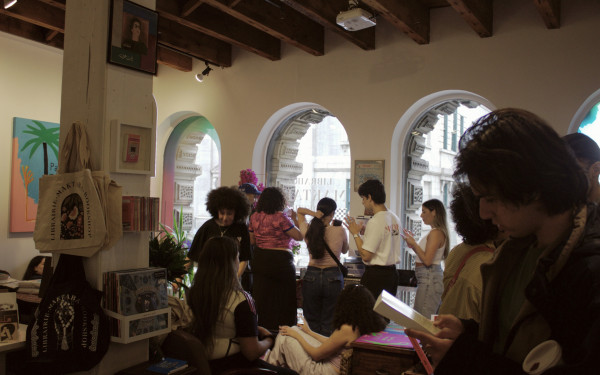Mile-Ex’s Death of Vinyl on keeping records alive
Co-Owner Daniel Hadley speaks on the history and future of vinyl in Montreal
The resurgence of vinyl records is undeniable. While sales are still down from their peak in the late 1970s, they have substantially increased in popularity, with the Recording Industry Association of America reporting that they’ve even outsold CDs for the first time since 1987.
Whether it’s older collectors looking for a hit of sweet nostalgia or younger shoppers looking for a deeper connection with the artists they love, increasingly more people are coming to appreciate owning physical copies of music.
When record store Death of Vinyl first opened in the early 2000s, some may have been unsure of vinyl’s longevity. “Many headlines at the time were asking ‘is this the death of vinyl?’” said co-owner Daniel Hadley. He said that Montreal vinyl shops, tailored for style-specific DJs that fueled the era’s nightlife, were closing left and right.
In 2006, Hadley and his business partner, Steve Ludvik, were running a vinyl import and distribution business out of a warehouse near the end of Beaubien Street West. All of a sudden, they found their business model collapsing. Both their distributors and the stores they sold to were closing up shop, leaving their business directionless.
However, as one door closed, another one opened.
Hadley began to notice the resurrection of independent record stores—places that ditched genre-specific catalogues in favour of wider ranges of sounds. Without much to lose, in the spring of 2007, the two owners opened up a section of the warehouse for the public to shop in.
Their plan was music to customers’ ears.
By the fall of 2007, their new business model was so effective that they decided to set up shop in earnest.
When Hadley and Ludvik moved into their first location, a second-floor vacant nightclub, Death of Vinyl was born. By 2017, they moved to their current location at Beaubien Street East and St. Laurent Boulevard.
Despite Death of Vinyl’s longevity, Hadley noted how hard it can be to stand out in a city full of vinyl.
“Montreal has too many record stores, so things can be tight,” he said. Hadley added that despite the relatively thin profit margins, spending money on records for the store is the best way to keep customers interested, instead of diverting them to the competition. “You’re gonna find all the different styles here […] we’re the safest place in the city to discover things you’re curious about.”
The store takes pride in having a uniquely holistic organizational style. For instance, instead of sorting their 12-inch records by time period or location, they are sorted by the type of rhythm or instrumentation they have. “A lot of music from the 1980s and 2000s share similar sounds. So why separate them?” Hadley said.
Hadley also reflected on how the clientele at the store has changed over time. He referenced a chart he had made which showed each age group—from the Silent Generation to Gen Z—and how they might be purchasing music in each decade.
When the store first opened, they saw a mix of a few generations. Hadley recalled that the client base was mostly Gen-Xers, split into those who had never stopped collecting vinyl, as well as individuals who were rediscovering their love of collecting now that they had more time and money at their disposal.
He added that there were a decent amount of people in their teens and twenties who were discovering that they could own physical copies of music they loved for cheap.
Gen Z has also joined Death of Vinyl’s client base. Hadley said they are collecting more and more cassettes along with vinyls. He predicted that boomers and Gen X listeners would soon be selling off their collections to stores, and that many Gen Z shoppers would benefit from this wide selection.
A customer, Florian Tonello, agreed that vinyl is far from dying. “It’s coming back,” he said. “CDs died […] now the original versions of those recordings are back on vinyl.”
Tonello continued, saying that many chain stores that had stopped selling records were now getting them back in stock due to their profitability.
Another patron, June Skene, agreed that vinyl was definitely having a resurgence. Skene also mentioned that a lot of new music is being released as records, something which has not been common practice for a while.
Interestingly, Hadley noted that many vinyl buyers these days don’t listen to the records they buy. This was confirmed by a 2022 study conducted by Music Business Worldwide. The report showed that half of vinyl buyers in the U.S. did not own a record player at all. Skene was shocked after first hearing this statistic, but also understood why.
Hadley and Skene both mentioned that the value of owning a record can be the connection it gives the listener to the artist to the same extent as in the music itself. “If the stigma there goes away, the growth will be huge,” Hadley said.
Skene added that while they liked the availability of vinyl, they did not entirely like the way records are being seen as collectable items. Still, they acknowledged that most streaming services pay musicians a fraction of a cent per listen, and therefore, vinyl records are a good way to support your favorite band or singer.
“The problem lies in how the labels handle their artists,” said Skene. “I think the high price of new vinyl is sort of a byproduct of that.”
“People might just hold the record and look at the cover while listening to the music on Spotify, and there’s no shame in that,” Hadley said. “People need music for mental health. Once you own the vinyl, it has value to you regardless.”
This article originally appeared in Volume 44, Issue 5, published October 31, 2023.






